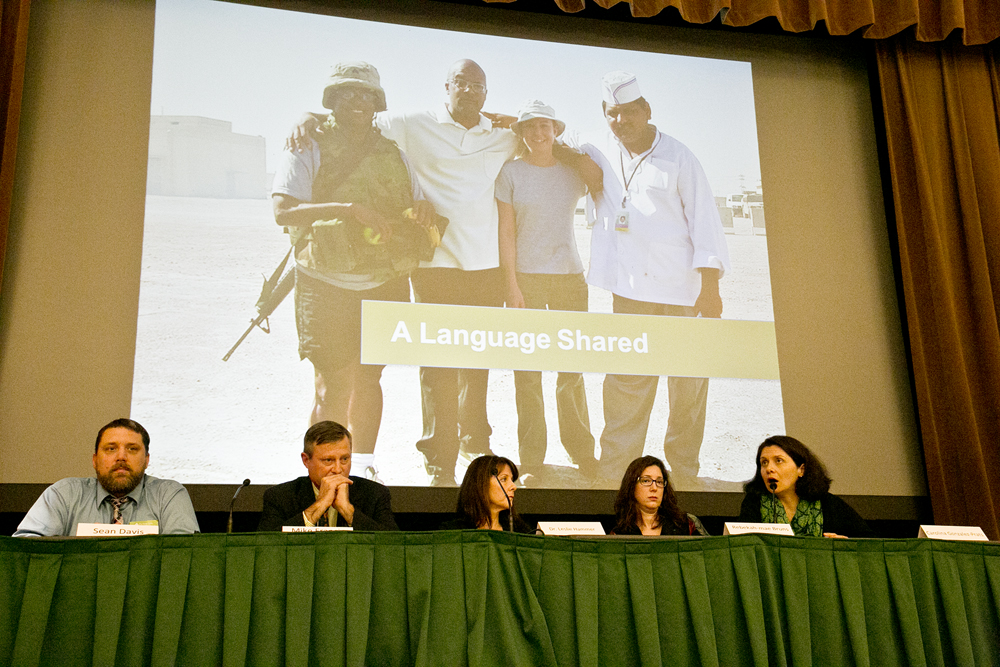Sporadic fighting and skirmishes ongoing in Iraq
U.S. Forces from the 4th Infantry Division captured the Taji Army Airfield northwest of Baghdad on Wednesday after sporadic fighting and bombing from U.S. warplanes.
Soldiers found large caches of rocket-propelled grenades, missiles and artillery rounds at the military facility about 15 miles northwest of the Iraqi capital.
A U.S. Kiowa helicopter fired missiles into a bunker laden with munitions, triggering thundering explosions and billowing mushroom clouds for 10 hours. Shock waves from the explosions could be felt for miles as detonated rockets and blazing debris landed hundreds of yards away.
U.S. warplanes also spotted seven surface-to-air missile sites around the airstrip, destroying five with 500-pound bombs. Hundreds of Iraqi civilians hoping to catch a glimpse of the spectacle gathered too close to the remaining two sites, which prevented U.S. forces from destroying them.
Soldiers from the 10th Cavalry, which took the brunt of the fighting, also detained about 110 men dressed in civilian clothing found walking along the road or driving trucks near a military compound. Ten were held for further questioning.
No U.S. troops were injured.
Elsewhere, American troops killed seven Iraqi civilians in the northern city of Mosul after the increasingly violent crowd began to attack, U.S. military officials said Wednesday.
The shooting underscored the difficulties that coalition forces face as they finish their combat missions and try to rebuild a country where many people remain anti-American.
“The Marines have to establish themselves,” said Marine Capt. Stewart Upton, a U.S. Central Command spokesman.
Marines also stopped a Baghdad bank robbery, recovering about $3.7 million, Central Command said Wednesday. Iraqis called the Marines on Tuesday after seeing looters in the bank. After the looters fired on the Marines, one Iraqi was killed, another injured and a third escaped.
Looting also continued Wednesday across Baghdad.
For several hours, throngs of Iraqis carried off 50-pound bags of sugar and 20-pound sacks of tea from storehouses inside the International Fair Compound. They double- and triple-parked on a major roadway – loading car trunks, back seats, roof racks and even occasionally backing up flatbed trucks – after Iraqis apparently discovered an intact rationing storehouse, and broke inside.
On Saadoun Street, young men could be seen piling through the broken front door of a bank branch in the late afternoon – but scattered when some Humvees roared into view.
Petty politics also appeared, for the first time in Iraqis’ memory.
Supporters of Kurdish leader Masoud Barzani plastered walls around the circle outside the Palestine Hotel with huge portraits of the Peshmerga leader sending his “deepest congratulations for a free, democratic transition in Iraq.” Hours later, they were all torn down.
And ministry buildings around Baghdad continued to burn. Sooty smoke still swirled from the Agriculture Ministry on Wednesday while, in front, young boys tore apart a metal statue of farming machinery, and carried the bits away.
Meanwhile, allied commander Gen. Tommy Franks made his first trip to Baghdad on Wednesday to visit his troops.
Elsewhere, coalition forces continued entering portions of northern and western Iraq where they had not yet been, seizing weapons from surrendering Iraqis, seeking out members of Saddam’s regime and delivering more humanitarian aid.
“We are going back to the smaller cities and towns that we initially bypassed on the way to Baghdad to rid any remaining regime presence,” Upton said. “We will continue these efforts until the regime has been removed from every corner of Iraq.”
In the town of Ramadi, about 60 miles west of Baghdad, the commander of Iraq’s 12th Armored Brigade surrendered to coalition forces. The Americans seized 40 tanks, nearly 1,000 weapons and some artillery.
In Kut, Iraqis directed troops to 2,000 mortar shells and several hundred rockets.
But the biggest challenge remains: finding weapons of mass destruction, whose alleged existence was President Bush’s primary justification for the war. If Saddam had them, he didn’t use them even as his regime fell. If they exist, they haven’t been found.
Troops are just beginning the “real heavy-duty work” of inspecting thousands of buried and hidden sites “one by one,” U.S. Brig. Gen. Vincent Brooks said. They’re also starting to question Iraqis who may have information.
“We’re just in the earliest stages of that,” Brooks told reporters Wednesday at coalition headquarters in Qatar. “It’s very much putting together pieces of a puzzle, one piece at a time. Only certain key regime leaders had the key to the puzzle.”
Finding those regime leaders has proven difficult, as many are believed to have fled. While that complicates the hunt for Saddam’s chemical and biological arsenal, Brooks said it doesn’t make the war a failure.
“If we don’t find every one of them, but we can account the regime is no longer in place, then we have succeeded,” he said.




